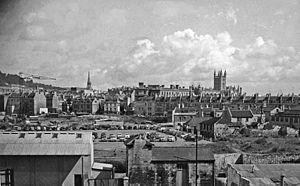Bath Blitz facts for kids
The Bath Blitz was a series of air raids on the city of Bath, Somerset, in the United Kingdom. These attacks were carried out by the German Luftwaffe (air force) during World War II.
The city was bombed in April 1942 as part of the "Baedeker raids". In these raids, Germany targeted cities for their cultural and historical importance, rather than for military reasons.
Contents
Why Was Bath Bombed?
Bath had many air raid warnings during the Blitz. This was a time when German planes bombed British cities at night. Often, German planes flew over Bath on their way to nearby Bristol, which was heavily bombed. Some bombs did fall on Bath in 1940 and 1941.
However, Bath was mostly safe until April 1942. This was when the "Baedeker Blitz" began. Germany started these raids after the British Royal Air Force (RAF) bombed the German city of Lübeck in March 1942. The Baedeker raids were Germany's way of striking back.
The Bombing Attacks on Bath
Over the weekend of April 25–27, 1942, Bath was attacked three times. About 80 German planes flew from areas of northern France that Germany had taken over.
When the city's sirens wailed, many people in Bath did not take cover. They thought the attack was meant for Bristol, a city nearby. Bristol had been bombed almost every night for four months. So, people in Bath did not expect the bombs to fall on their city.
First and Second Raids
The first raid started just before 11 pm on Saturday night. It lasted until 1 am. The German planes then flew back to France. They refuelled and loaded more bombs. Then, they returned at 4:35 am. Bath was still burning from the first raid. This made it easier for the German bombers to see their targets.
Third Raid and Machine-Gun Fire
The third raid began early on Monday morning. It lasted only two hours but caused a lot of damage. The bombers flew low to drop their powerful bombs and fire bombs. After dropping the bombs, they flew back over the streets. They fired machine guns at people below.
What Happened After the Raids?
The Bath Blitz caused a lot of damage and sadness.
- 417 people were killed.
- Another 1,000 people were injured.
- Over 19,000 buildings were hit.
- 1,100 buildings were badly damaged or completely destroyed.
- This included 218 buildings that were important for their history or design.
Damage to Famous Buildings
Houses in famous areas like the Royal Crescent, the Circus, and Paragon were destroyed. The Bath Assembly Rooms were burned out.
A large 500 kg (about 1,100 lb) bomb hit the south side of Queen Square. This damaged houses there. The Francis Hotel lost a large part of its front. Most buildings on Queen Square had damage from flying metal pieces. Not many people were hurt in the square. Most hotel guests and staff had gone to the hotel's basement for safety.
Many of Bath's churches were also badly damaged. St James Church and St Andrew's Church had to be pulled down. The site of St James Church is now a shop. The site of St Andrew's Church is now a park.
Many buildings have been fixed or replaced since the war. But you can still see some signs of the bombing today.
Remembering the Bath Blitz
After the raids, an air-raid shelter was built for people living in Queen Square. This shelter was in the private garden in the middle of the square. In 1948, the people living there gave the garden to the city of Bath. They wanted it to be a memorial for those who died in the attacks. Today, the square is used for many community events. These include the Jane Austen Festival and the annual Bath Boules Tournament.
Willi Schludecker was a German pilot who flew many missions, including the Bath Blitz. In 2008, when he was 87, he visited Bath for its yearly remembrance service. He died in 2010 at age 90.
Among the firefighters who helped in Bath was Harry Patch. He later became the last surviving British soldier who fought on the front lines in the First World War.
In 2016, a live 500 lb (about 227 kg) bomb was found. Workmen discovered it under a playground at the old Royal High School, Bath site. The bomb had been there for over 70 years. A bomb disposal team safely removed it. They then took it to a quarry and blew it up.
Images for kids





